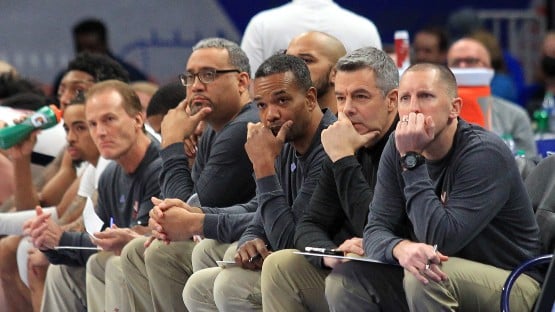
U.S. Women’s National Team member Sophia Smith honored her late former teammate Katie Meyer at the at the Women’s World Cup. Smith had just scored her second goal at a match against Vietnam and made the same “zip-your-lip” motion that Meyer made at a previous match in a video that went viral when the pair was in college.
In March 2022, Meyer died by suicide. “I think the hardest part was there weren’t any signs of anything,” Smith said in a podcast. “You wouldn’t know she was hurting.”
As the boys’ varsity basketball coach at Aliso Niguel High School in Aliso Viejo, California, I’ve witnessed these realities myself. You could say I’m a parental figure to the athletes with whom I work, and as such, I feel a huge responsibility to look after their mental health and development. I do this with the intention of providing student-athletes with the tools necessary to succeed both on and off the basketball court.
Unfortunately, Katie Meyer’s a situation that’s not all that uncommon. In fact, in a 2021 NCAA survey, 24 percent of male student-athletes and 36 percent of female student-athletes said that they struggled to keep their mental health in check.
Pair that with the fact that more than 50 percent of high school-aged kids admit to misusing at least one substance and we’re truly doing our children a disservice by not opening up about the dangers of drugs and the perils of neglecting our mental health. In the 15 years that I’ve been coaching, I’ve noticed a serious stigma in talking about drugs and mental health in the classroom.
There’s an age-old saying that goes, “An ounce of prevention is worth a pound of treatment.” I’ve found few things as true as this. In order to help our students, we have to do what we can to prevent them from using lethal drugs—and a big part of that is checking in with them about their mental health.
In the following sections, I’ll share my expertise in creating a supportive, trauma-informed community for student-athletes through various modalities of support.
The importance of mental health, interpersonal support, and community for student-athletes
Mental health
The root issue that we’re dealing with when we’re addressing substance use disorder is mental health. It can be challenging to open up this dialogue.
However, doing so is absolutely crucial. Less than half of all student athletes feel comfortable seeking support from a mental health provider on campus, so the onus is on us to make them feel like they can reach out.
Interpersonal support
By checking in on your student-athletes, you’re creating the interpersonal support necessary for them to be open about their mental health challenges—and that has a positive domino effect. Creating this support can be as simple as asking how they’re doing, if they’re struggling with anything, or if there’s anything that you might be able to do to better support them.
Community
It’s important to understand that interpersonal support is part of being in a community, but it’s not community itself. When you’re coaching a team, you’re also leading a community—and those aren’t built overnight. We need to make sure that we’re building community through various modalities—which I talk about below.
Modalities to create a trauma-informed community for student-athletes
One-on-one coach-to-athlete check-ins
For as long as I’ve been coaching, I’ve known that a key part of the job is talking to the student-athletes and learning about their personal experiences. Let’s say there’s an athlete who has been showcasing uncharacteristically combative behavior (a symptom of drug use). I wouldn’t treat that athlete the same way I would someone who recently showed a decrease in enjoyment of their favorite sport (which can be a sign of depression).
These standing check-ins allow the student-athlete to open up in a safe and familiar space. They also give coaches a peek into the athlete’s life, which can be helpful in building individualized coaching plans.
Peer support groups
Peer support groups are another modality I’ve incorporated into my coaching practices. Anyone who’s spent any amount of time with a teenager—or a group of them—knows that kids listen to other kids. That’s precisely why peer support groups are so effective in mental health and drug prevention among student-athletes.
This group of people has no shortage of things to stress them out. Often times, however, they feel like they’re at it alone; they may even think that complaining is weak and unacceptable. This, of course, is the furthest thing from the truth. Putting kids in peer support groups helps them to see that there are other people with very similar struggles—and that those struggles are nothing to be ashamed of.
Community engagement
I said earlier that communities are not built overnight. I’d now like to add: Community needs consistent nurturing—and that’s where community engagement comes in. I also said that I want my students to succeed on and off the court. Community engagement is handy in off-the-court success, too.
My players feel better when they see themselves as a whole person and not just a student-athlete (which contributes to the pressure they feel). For this reason, we’ll often engage in activities not related to basketball.
Talking openly about mental health and developing substance avoidance strategies among high school student athletes is undeniably beneficial for both their overall well-being that extends beyond their athletic performance for the long term. By talking openly about mental health and substance abuse early on, we can create a supportive and positive environment that fosters physical and emotional growth and helps our kids cope with daily stressors in a healthy way.
Parham Nematollah is the CEO of Buckeye Recovery Network.
Project Mental Health aims to connect you with the resources available in our community that can give you the help you need. We aim to get you connected with the people in Augusta County, Staunton and Waynesboro who can help get you back on track.










